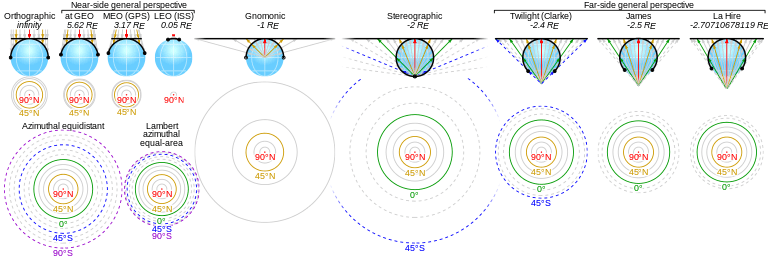General Perspective projection

The General Perspective Projection is a map projection of cartography.
When the Earth is photographed from space, the camera records the view as a perspective projection. If the camera precisely faces the center of the Earth, the projection is Vertical Perspective. Otherwise, a Tilted Perspective projection is obtained.
The Vertical Perspective is related to the Stereographic projection, Gnomonic projection, and Orthographic projection. These are all true perspective projections, and are also azimuthal (the projection surface is a plane tangent to the sphere, and directions from one central point to any other point are correct). The point of perspective for the General Perspective Projection is a finite distance. It depicts the earth as it appears from some relatively short distance above the surface, typically a few hundred to a few tens of thousands of kilometers.
Tilted Perspective projections are not azimuthal (see second figure below); directions are not true from the central point, and the projection plane is not tangent to the sphere.
Some forms of the projection were known to the Greeks and Egyptians 2,000 years ago. It was studied by several French and British scientists in the 18th and 19th centuries. But the projection had little practical value; computationally simpler nonperspective azimuthal projections could be used instead.
Space exploration led to a renewed interest in the perspective projection. Now the concern was for a pictorial view from space, not for minimal distortion. A picture taken with a hand-held camera from the window of a spacecraft has a tilted vertical perspective, so the manned Gemini and Apollo space missions sparked interest in this projection.
Some prominent Internet mapping tools also use the tilted perspective projection. For example, Google Earth and NASA World Wind show the globe as it appears from space. These applications permit a wide variety of interactive pan and zoom operations, including fly-through simulations, mimicking pictures or movies taken with a hand-held camera from an airplane or spacecraft.

